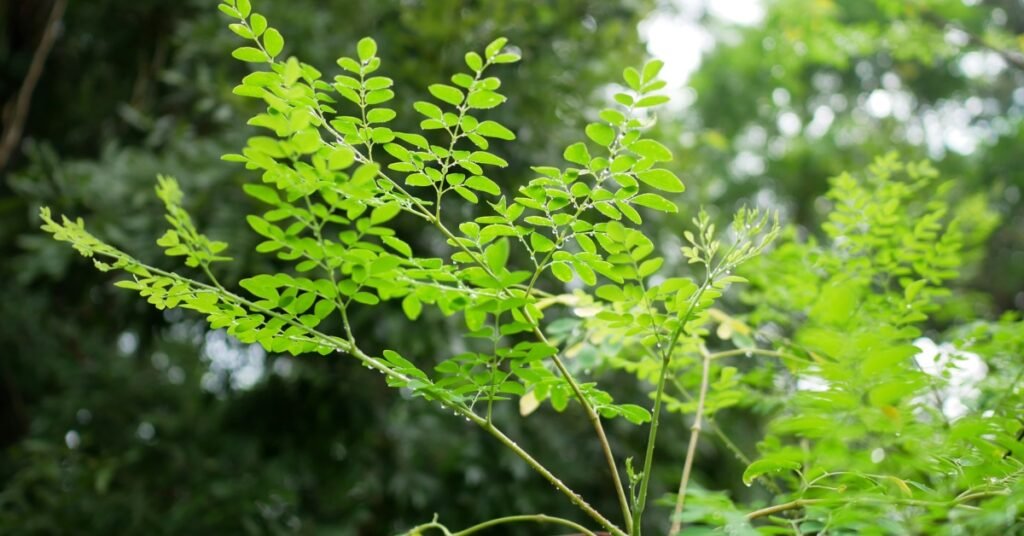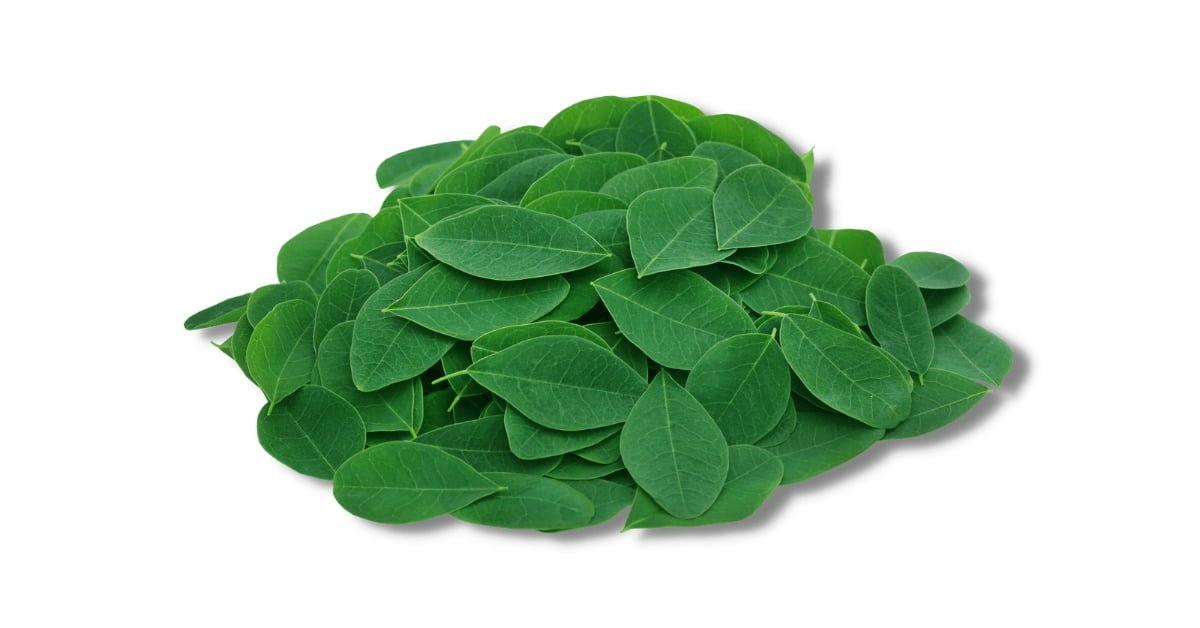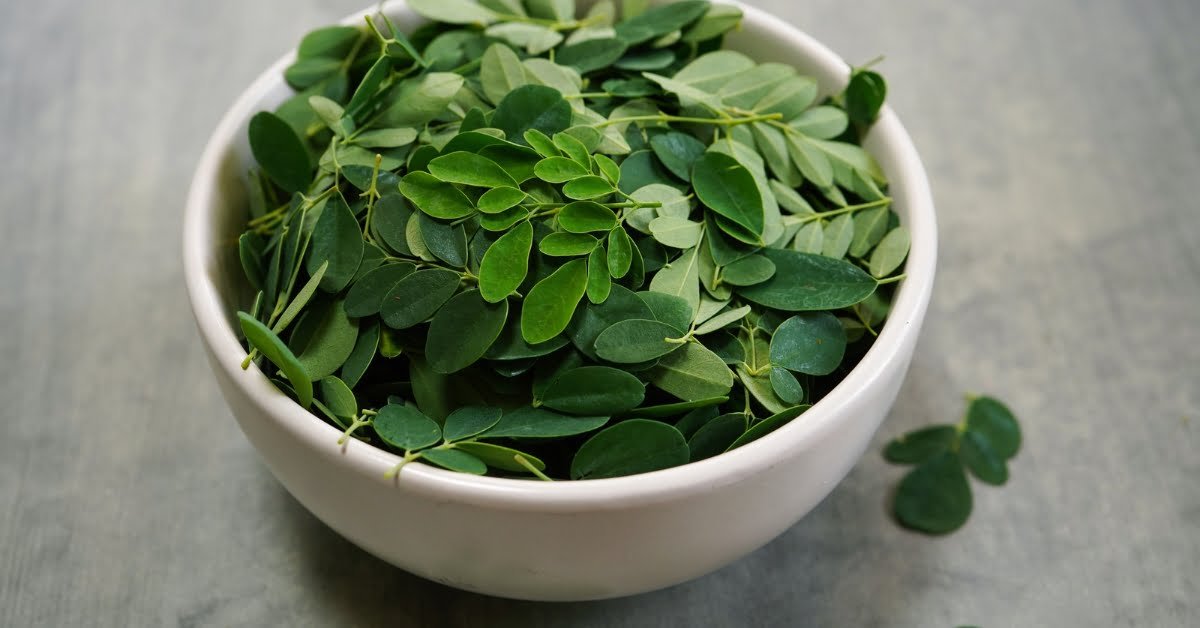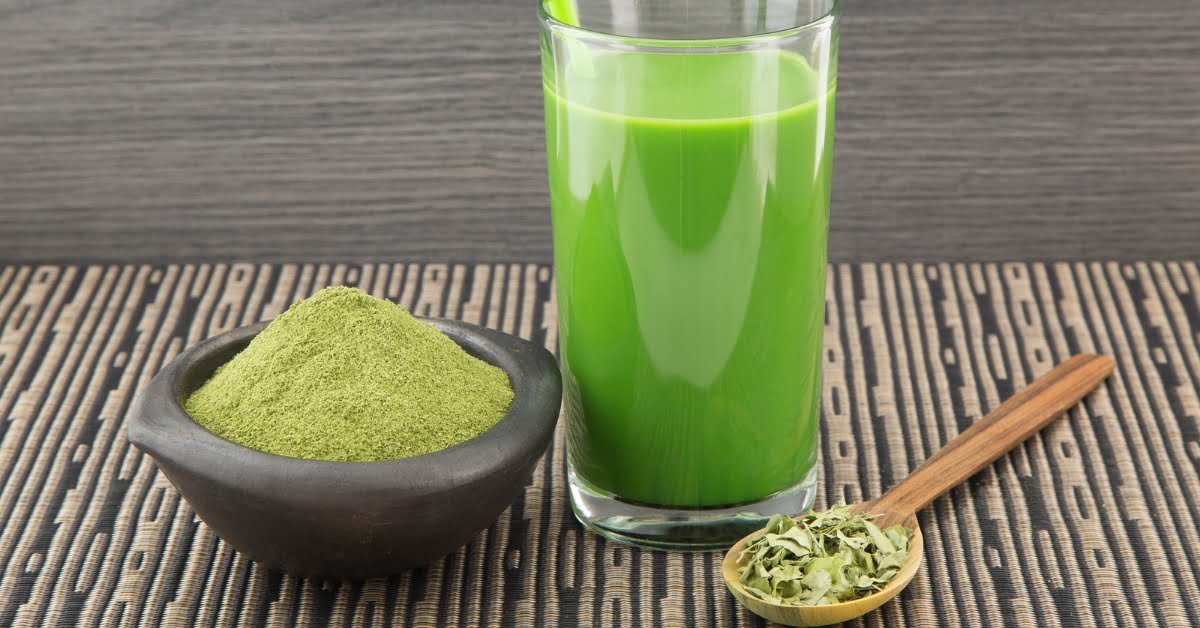Moringa oleifera is a fast–growing, drought–resistant tree native to the southern foothills of the Himalayas in northwestern India. It is also found in Pakistan, Nepal, Bangladesh, Sri Lanka, and Morocco. The tree grows to a height of 33′–39′ feet with a trunk up to 16″ inches in diameter. The leaves are green and pinnate with 7–9 leaflets. The flowers are white or pinkish–white with four petals. Moringa oleifera fruits are small brownish–black pods that contains typically between 3–5 seeds each.
Dwarf Moringa
| Common Names or AKA Names: |
|
| Botanical Name: | Moringa oleifera |
| Family: | Moringaceae |
| Plant Type (Zone 8b): | Perennial |
| Hardiness Zones: | Zones 8b through 12 |
| Mature Size: | 5′ – 39′ feet tall |
| Native Area: | This variety is from India but in general Africa, Asia, and South America. |
| Bloom/Harvest Time: | Blooms in Spring | Can harvest the leaves/blooms/breadsticks/seeds and immature seedpods at any time. |
| Sun/Light Exposure: | 8 to 12 hours of Light. |
| Planting Depth: | 3/4″ to 1″ in Depth. |
| Soil Preferences: | Sandy, Well–Drained Soils |
| Soil pH: | 7.0 |
| Aquaponically-Friendly: | NO | LEARN MORE |
| Hydroponically-Friendly: | NO | LEARN MORE |
DESCRIPTION:
Moringa is a tree that is native to the tropics and subtropics. It is easy to grow as an annual in the North. Moringa contains 46 antioxidants, 18 amino acids and is a complete protein. This dwarf variety from India is well suited to container growing, which makes it easier to grow in the United States. Moringa leaves, blooms, breadsticks, seeds and immature seedpods are edible. This plant is prized for its very high-protein leaves, its rich concentration of minerals and vitamins, and its heavy load of anti-oxidants! Seeds are a source of high-quality oil. Green Grass Grove grows a very special dwarf variety that originated from India. Unlike other varieties of moringa, this tree will remain short and is very well suited to container growing, which makes growing it in the U.S. much easier.
The leaves of Moringa oleifera are rich in nutrients including vitamins A and C, calcium, iron, potassium, and protein. They can be eaten fresh or dried and powdered for use as a seasoning or thickener in soups and stews. Moringa leaves have a slightly bitter taste, similar to spinach or kale. The flowers and pods are slightly sweet and the seeds have a nutty flavor. The leaves are also used as animal feed.
The bark and roots of Moringa oleifera have traditionally been used for their medicinal properties. Preparations made from these parts of the tree have been used to treat various ailments such as diarrhea, dysentery, fever, headaches, hypertension, skin diseases etc.
Moringa oleifera is a versatile tree with many uses. It has the potential to improve the lives of people in developing countries who do not have access to nutritious food or adequate medical care. Moringa leaves contain 7 times the amount of Vitamin C as oranges, 4 times the amount of Vitamin A as carrots, 4 times the calcium as milk, 3 times the potassium as bananas, and 2 times the protein of yogurt.
USE:
The Moringa Tree is mostly grown for its leaves, which are rich in vitamins and minerals. The leaves are often used fresh or dried in curries and other dishes. The seeds can be used to purify water or pressed to extract their oil, which has numerous applications in cosmetics and medicine. The small, round fruits of the tree are sometimes used in traditional medicine.
Culture & Cultivation:
The moringa tree is a fast–growing, drought–resistant tree that can reach up to 20 feet in height. It is native to the Indian subcontinent and has been used for centuries in Ayurvedic medicine. The leaves, seeds, and oil from the moringa tree are all edible and have a variety of health benefits. The leaves are high in vitamins A, C, and E, as well as calcium and protein. The seeds can be used to purify water or pressed to extract their oil, which is rich in antioxidants and has anti–inflammatory properties. The tree also produces small, round fruits that are sometimes used in traditional medicine.
If you want to learn more about cultivating this specific plant, you might want to check out our online courses where we have plant specific mini courses in addition to our standard fully packed courses and master gardening courses.
Planting & Care:
To grow Moringa from seed, first soak the seeds in very warm water for 2-3 days, rinsing often. Then, plant the seeds in a pot filled with well-draining soil. Water the soil until it is moist but not soggy, and place the pot in a warm, sunny location. Keep the soil moist but not wet, and within 2-3 weeks the seeds should germinate. Once they have germinated, thin out the seedlings so that only one remains per pot.
To grow Moringa from cuttings, take 6-8 inch cuttings from a healthy Moringa tree. Remove any leaves from the bottom half of the cutting, and dip the end into rooting hormone powder. Plant the cutting in a pot filled with well-draining soil, and water it until moist but not soggy. Place the pot in a warm, sunny location, and keep an eye on it to make sure that it doesn’t dry out. Within 4-6 weeks roots should begin to form at the bottom of the cutting. Once roots have formed, transplant them into a larger pot or into your garden bed.
When planting a small Moringa Tree outdoors: Choose a spot in full sun and dig a hole twice as wide as your tree’s root ball but just deep enough so that when you replant your tree it will be at ground level (or slightly above). Amend heavy clay soils with organic matter prior to planting to help improve drainage if needed – sandy soils need less amendment since they already drain well on their own! Gently remove your tree from its container being careful not to damage its roots then place it in the center of the prepared hole backfilling around the root ball with amended native soil tamping lightly as you go ensuring there are no air pockets present which could lead to drying out/drowning the roots of your new tree later on down the road. Water deeply immediately after planting and be sure to keep an eye on it during the first growing season making sure it doesn’t dry out – a good rule of thumb is to water as you would a new lawn!
Growing new plants can be difficult at times but not to worry Green Grass Grove Academy is here to help! We are excited to offer Online Courses on plant care and other Gardening and Homesteading Courses. Our goal is to provide you with the knowledge and skills necessary to become a successful gardener. Our Online Courses are designed to be self-paced and to be completed at your convenience. Courses contain invaluable information to help you become the ultimate Gardener! In addition, Our Courses have entertaining multimedia, quizzes, and a final exam to test your knowledge. Upon completion of each course, you are eligible to receive a certificate of completion. Some of our most popular courses include Aquaponics/Hydroponics, Plant Pathology, Seeds & Seedlings, Microgreens, Plant Mini-Courses, and Insect Pest & Nutrients Management.
So what are you waiting for? Come on over to Green Grass Grove Academy and let us help you become the ULTIMATE GROWER!
Watering:
When watering a dwarf moringa tree, it is important to water the roots and not the leaves. To water the roots, use a garden hose or drip irrigation system and direct the water at the base of the tree. Avoid getting the leaves wet as this can promote fungal growth. Water early in the day so that the leaves have time to dry before nightfall.
Harvesting:
Moringa Trees can be harvested for their leaves, flowers, pods, and seeds. The leaves can be harvested at any time once the tree has reached 6–8 inches in height. To harvest the leaves, cut them off at the stem using pruning shears. The flowers and pods can be harvested when they are young and tender. To harvest the flowers, cut them off of the stem just below the flower head. To harvest the pods, cut them off of the stem when they are 3–4 inches long. The seeds can be harvested from mature pods that have turned brown and dry on the tree. To harvest the seeds, open up the pod and remove them from inside.
To dry the leaves, flowers, and pods, lay them out on a flat surface in a well–ventilated area out of direct sunlight. Allow them to dry for 1–2 weeks until they are completely dried out. Once they are dried, store them in an airtight container in a cool, dark place. To cure the seeds, spread them out on a flat surface and allow them to air dry for 1–2 weeks. Once they are fully dry, store them in an airtight container in a cool, dark place.
To make Moringa powder, simply grind the dried leaves, flowers, and/or seeds into a fine powder using a coffee grinder or food processor. To extract oil from Moringa seeds, first-cold press the seeds to yield a crude oil. This crude oil can then be refined to produce a higher quality oil.
Aphids | Whiteflies | Mealybugs
Take Our Online Insect Pest Management Course to become an expert at dealing with these pests and others too!
Learn More About This Plant!
- The flowers are fragrant and hermaphroditic, surrounded by five unequal, thinly veined, yellowish-white petals. The flowers are about 3⁄8″ – 5⁄8” inches long and 3⁄4″ inches broad. They grow on slender, hairy stalks in spreading or drooping flower clusters, which have a length of 4″ – 10″ inches.
- Moringa oleifera leaves can be used fresh or dried and powdered for use as a seasoning or tea.
- The oil from Moringa oleifera seeds has traditionally been used for cooking and lighting in many parts of Africa and Asia.
- More recently, Moringa oleifera oil has been shown to be effective at purifying water polluted with heavy metals or organic contaminants such as pesticides.
- Moringa oleifera wood is very hard and dense, making it ideal for use in construction, furniture making, and other woodworking applications.
- Moringa oleifera trees are also being investigated for their potential use in phytoremediation, or the process of using plants to remove contaminants from soil and water.
- In some parts of the world, Moringa oleifera is considered an invasive species due to its rapid growth and ability to crowd out native vegetation.
- Moringa oleifera has a long history of use in traditional medicine, particularly in Ayurvedic and Siddha systems of medicine.
The information in this post is NOT medical/nutrition advice, as we are not doctors or nutritionists. This information is for informational/entertainment purposes only and is not a substitute for professional medical advice, nutrition advice, diagnosis or treatment. If you have any concerns or questions about your health or nutrition intake, you should always consult with a doctor or other licensed and qualified healthcare professional.
Green Grass Grove Plant Profiles
No posts found!






